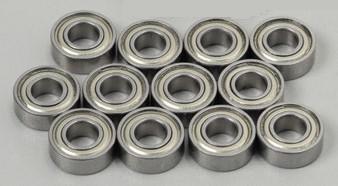Why ball bearings?
 That's right, why? Why so many people recommend to replace plastic or metal bearings included in kits with ball bearings? If they were so important, how come they are not in every kit box? Some manufacturers include them, others don't or not for all their models. Here like so often, the main reason is cost-related: not that a ball bearing set is that expensive, but it saves a few euros on the final kit price. On the other hand, 15 to 30 years ago for the first models, the price was just prohibitive.
That's right, why? Why so many people recommend to replace plastic or metal bearings included in kits with ball bearings? If they were so important, how come they are not in every kit box? Some manufacturers include them, others don't or not for all their models. Here like so often, the main reason is cost-related: not that a ball bearing set is that expensive, but it saves a few euros on the final kit price. On the other hand, 15 to 30 years ago for the first models, the price was just prohibitive.
Tamiya only sells a few kits fully ball raced, generally hopped-up or race-oriented kits. For all the others, plastic or metal bearings are provided.
Those plastic bearings feature everything you want to avoid:
- high friction resistance
- prone to worn, meaning rapid play
Metal bearings don't wear (or very few), but they share the same friction resistance with plastic bearings.
Friction resistance is a major flaw since it puts a strain on the model performance: on a buggy like the Baja King, the difference is about 5 km/h. Same thing on an on-road chassis like the TT-01: 5 km/h it's not much. Now, say it differently: we're talking about a better top speed by 20% in both examples. Acceleration is about 5 to 7% faster, and the time needed to get from 0 to 20 km/h is reduced by 33%. I recommend you read this article (French only, sorry, but you'll understand the tables and graphs): TT Performance Analyser.
This friction resistance leads to another problem: shorter running times. The whole transmission is not free so the motor effort needs to be greater to overcome the friction resistance of the moving elements: thus it draws much more current, exactly like a car hauling a caravan.
With time, the plastic bearings have an impact on the overall model reliability because they tend to wear. The pinions which are designed to precisely fit tend to become looser: they suffer from play which leads to wear them much sooner.
Conclusion is obvious: plastic and metal bearings are evil! Ball bearings are the best and they will save poor planet Earth! Well, sorry ![]() The one and only must-have option for any model is a full ball bearing set.
The one and only must-have option for any model is a full ball bearing set.


Now that you now why you need ball bearings, let's see which ones your model needs.
Ball bearings references and sizes
In their manuals, Tamiya use references for their plastic and metal bearings: their ball bearings share the same reference. If most of the LHS know how to convert Tamiya references in standard measures, it's always better to check twice. Even more since Tamiya use the outer / inner diameter convention to name their ball bearings when the industry uses the reverse. The following table will help: all meassures are in millimeters.
| Reference | Inner Diameter | Outer Diameter | Thickness |
| 620 | 2 | 6 | 2,5 |
| 630 | 3 | 6 | 2,5 |
| 730 | 3 | 7 | 3 |
| 830 | 3 | 8 | 2,5 |
| 840 | 4 | 8 | 3 |
| 850 | 5 | 8 | 2,5 |
| 950 | 5 | 9 | 3 |
| 1050 | 5 | 10 | 4 |
| 1060 | 6 | 10 | 3 |
| 1150 | 5 | 11 | 4 |
| 1160 | 6 | 11 | 4 |
| 1260 | 6 | 12 | 4 |
| 1280 | 8 | 12 | 3,5 |
| 1510 | 10 | 15 | 4 |
| 1680 | 8 | 16 | 5 |
| 2415 | 15 | 24 | 5 |
| 2617 | 17,5 | 26 | 5 |
Table based on the work of Savage-91 from Vintage-RC
Whenever you need ball bearings, either your local hobby shop or any internet seller uses Tamiya naming for bearings (1150 for example), or you will need to translate it into the usual industry standard (5x11x4 for this example). Don't worry, any 5x11x4 ball bearing will perfectly fit any Tamiya recommended 1150, and reverse.




